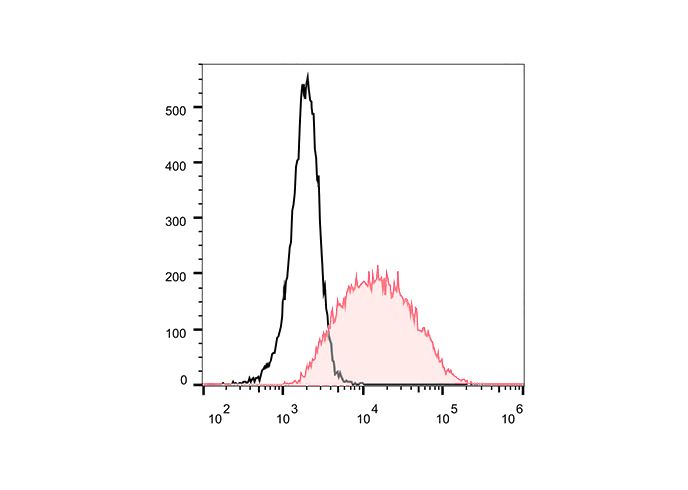Products
FineTest®700 Anti-Mouse CD34 Antibody(RAM34)
- SPECIFICATIONS
- FIGURES
- CONDITIONS
- FAQS
- Product Name
- FineTest®700 Anti-Mouse CD34 Antibody(RAM34)
- Catalogue No.
- F700-30145
- Form
- liquid
- Conjugation
- FineTest®700
- Conjugation Information
- FineTest® 700 is designed to be excited by the Red laser (627-640 nm) and detected using an optical filter centered near 719 nm (e.g., a 725/40 nm bandpass filter).
- Clonality
- Monoclonal
- Isotype
- IgG2a, κ
- Clone ID
- RAM34
- Storage
- PBS with 0. 1% sodium azide, 1%BSA, pH 7.3, 2-8℃ for 12 months (Avoid repeated freeze / thaw cycles.)
- Alternative Names
- Hematopoietic progenitor cell antigen CD34 antibody
- UniProt ID
- Q64314
- Tested Applications
- FC
- Recommended dilution
- Volume per test: 5μL. Each lot of this antibody is quality control tested by flow cytometric analysis. The amount of the reagent is suggested to be used 5 µL of antibody per test (million cells in 100 µL staining volume or per 100 µL of whole blood). Please check your vial before the experiment. Since applications vary, the appropriate dilutions must be determined for individual use.
 Staining of the NIH/3T3 cells with FineTest®700 Anti-Mouse CD34 Antibody(RAM34)(filled gray histogram) or FineTest®700 Rat IgG2a, κ Isotype Control(black histogram).Total viable cells were used for analysis.
Staining of the NIH/3T3 cells with FineTest®700 Anti-Mouse CD34 Antibody(RAM34)(filled gray histogram) or FineTest®700 Rat IgG2a, κ Isotype Control(black histogram).Total viable cells were used for analysis.
- Background
- The RAM34 antibody reacts with the CD34 glycoprotein on the surface of three independently derived mouse CD34-transfected cell lines. RAM34 antibody also reacts with the mouse cell lines PA6, 416B, Swiss 3T6, NIH, 3T3, DA1, and M1, all of which are positive for expression of mouse CD34 mRNA. Cell lines shown to be negative for CD34 transcript, including WEHI-3B, EL4, 18.8, and CMT64/61, are also negative for surface expression of CD34 as determined by RAM34 staining. Normal thymocytes and splenocytes are negative for CD34 expression. In the bone marrow, 7-10% of cells are stained with RAM34 mAb, including most of the Ly-6A/E (Sca-1)+ CD90 (Thy-1)low Lineage Marker- hematopoietic stem cell-enriched subpopulation and myeloerythroid progenitors. CD34 is also expressed on a small percentage of fetal liver cells, including NK-cell progenitors. CD34 has been reported to be expressed on the endothelium of capillaries and, in this form, to function as a ligand for L-selectin. Consistent with this observation, RAM34 antibody stains endothelial cells in spleen, thymus, and postcapillary HEVs in the lymph nodes. It is reported that RAM34 antibody can be used to select CD34+ CD117 (c-Kit)+ Ly-6A/E (Sca-1)+ Lineage Marker- bone marrow-derived hematopoietic stem cells, capable of short-term multi-lineage reconstitution of lethally irradiated mice; while the CD34- CD117+ Sca-1+ Lineage Marker- population contains self-renewing hematopoietic stem cells. Similarly, the bone marrow population with high dye-efflux capacity and which is highly enriched for long-term reconstituting hematopoietic stem cells is CD34- CD117 (c-Kit)+ Ly-6A/E (Sca-1)+ Lineage Marker-.
How many times can antibodies be recycled?
First, usually it's not suggested to recycle antibodies. After use, buffer system of antibodies has changed. The storage condition of recycled antibodies for different customers also varies. Thus, the performance efficiency of recycled antibodies can’t be guaranteed. Besides, FineTest ever conducted the antibody recycling assay. Assay results show recycling times of different antibodies also varies. Usually, higher antibody titer allows more repeated use. Customers can determine based on experimental requirements.
Notes: After incubation, we recycle rest antibodies to centrifuge tube and store at 4℃. High titer antibodies can be stored for a minimum of one week. Reuse about three times.
What are components of FineTest antibody buffer?
Components of FineTest antibody buffer are usually PBS with proclin300 or sodium azide, BSA, 50% glycerol. Common preservative is proclin300 or sodium azide, which is widely applied in the lab and industry.
How about the storage temperature and duration of FineTest antibodies?
Most antibodies are stored at -20℃. Directly-labeled flow cytometry antibodies should be stored at 2 - 8℃. The shelf life is one year. If after sales issues for purchased antibodies appear, return or replacement is available. Usually, antibodies can be still used after the one-year warranty. We can offer technical support services.
Is dilution required for FineTest antibodies? What’s the dilute solution?
Directly-labeled flow cytometry antibodies are ready-to-use without dilution. Other antibodies are usually concentrated. Follow the dilution ratio suggested in the manual. Dilute solution for different experiments also varies. Common antibody dilution buffers are acceptable(e.g. PBST, TBST, antibody blocking buffer).
How to retrieve antibodies for immunohistochemistry?
Common retrieval buffers: Tris-EDTA Buffer(pH 9.0); Citrate Buffer(pH 6.0)
Heat induced antibody retrieval:
Method 1: Water-bath heating: Put the beaker with retrieval buffer and slide in the boiling water bath. Keep the boiling state for 15min. Naturally cool to room temperature;
Method 2: Microwave retrieval: Put the beaker with retrieval buffer and slide in the microwave oven. Heat at high power for 5min, Switch OFF for 3min, Heat at medium power for 5min. Naturally cool to room temperature.
How to choose secondary antibodies?
(1) Secondary antibodies react with primary antibodies. Thus, secondary antibodies should be against host species of primary antibodies. E.g. If the primary antibody is derived from rabbit, the relevant secondary antibody should be against rabbit. E.g. goat anti rabbit or donkey anti rabbit.
(2) Choose secondary antibody conjugates according to the experimental type, e.g. ELISA, WB, IHC etc. Common enzyme conjugated secondary antibodies are labelled by HRP, AP etc. Fluorescin or dye labelled secondary antibodies are applied in immunofluorescence and flow cytometry(e.g. FITC, Cy3).
